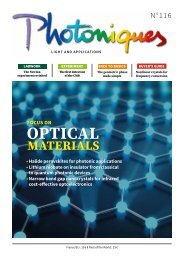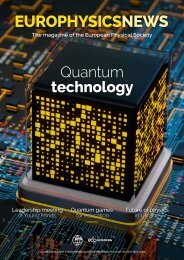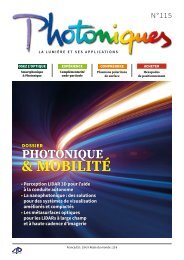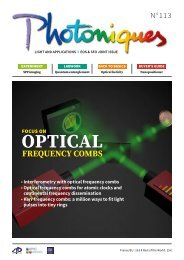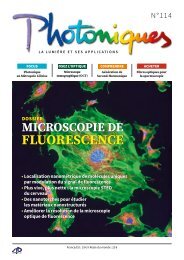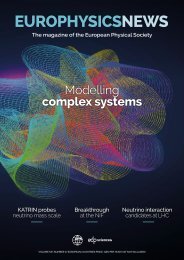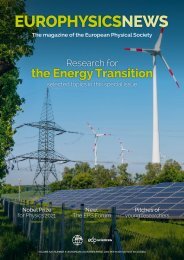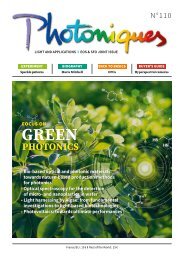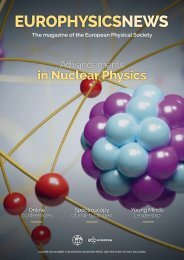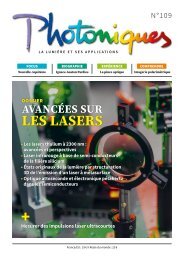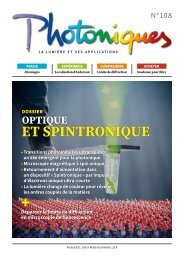EPN 53-3
You also want an ePaper? Increase the reach of your titles
YUMPU automatically turns print PDFs into web optimized ePapers that Google loves.
FEATURES<br />
PLASMA<br />
MEDICINE:<br />
THE GREAT<br />
PROSPECTS<br />
WHEN PHYSICS<br />
MEETS MEDICINE<br />
l J.M. Sadowska 1 , N. Skoro 2 , R. Laurita 3 , S. Bekeschus 4 ,<br />
A. Przekora-Kuśmierz 5 , A. Lin 6 , S. Laurencin 7 , S. Sério 8 ,<br />
S. Cousty 7 , C. Canal 9<br />
l DOI: https://doi.org/10.1051/epn/2022303<br />
l 1 Royal College of Surgeons in Ireland University of Medicine and Health<br />
Sciences, Dublin, Ireland<br />
l 2 Institute of Physics, University of Belgrade, Belgrade, Serbia<br />
l 3 Department of Industrial Engineering, Alma Mater Studiorum-Università di<br />
Bologna, Italy<br />
l 4 ZIK plasmatis, Leibniz Institute for Plasma Science and Technology<br />
(INP), Germany<br />
l 5 Unit of Tissue Engineering and Regenerative Medicine, Medical University<br />
of Lublin, Poland<br />
l 6 Plasma Lab for Applications in Sustainable and Medicine-Antwerp,<br />
University Antwerp, Belgium<br />
l 7 Toulouse Health Faculty, CHU Toulouse, Paul Sabatier University, France.<br />
l 8 Department of Physics, NOVA University Lisbon, Portugal<br />
l 9 Research Center for Biomedical Engineering, Universitat Politècnica de<br />
Catalunya, Spain.<br />
The research has demonstrated<br />
the antimicrobial properties of<br />
plasma urging the incorporation of<br />
cold atmospheric plasma (CAP)<br />
decontamination in current clinical<br />
therapies with the aim to improve the<br />
benefits on the patients and on society.<br />
Plasma medicine is an innovative and interdisciplinary<br />
field of science which has experienced<br />
an immense international upswing in<br />
the last years. It has emerged two decades ago<br />
as a commingling of plasma technology with physics,<br />
chemistry, engineering and life science. The final aim<br />
of plasma medicine research is to introduce CAPs into<br />
clinical medicine and bioengineering fields for human<br />
and veterinary therapeutic applications [1].<br />
What is plasma and how it works?<br />
Gas discharge plasma is an ionized gas, composed of free<br />
electrons, ions, radicals, excited atoms and molecules,<br />
neutral molecules, electromagnetic fields and UV-Vis<br />
radiation with no net electrical charge [1] (Figure 1).<br />
The features of CAP, according to their non-equilibrium<br />
character, include the extremely high concentration of<br />
chemically reactive species and a bulk temperature close<br />
to the room temperature, which makes it an ideal tool<br />
for applications in many fields including agriculture, environment,<br />
manufacturing and most of all, medicine.<br />
The reactive species, derived from oxygen and nitrogen<br />
(RONS - i.e. O, 1 O 2 , O 3 , ·OH, ·O 2 H, ·O 2- , ·O 3- , ·NO, ·NO 2 )<br />
are particularly relevant for the medical field as they can<br />
diffuse from the gas phase to a solution/biological medium,<br />
generating less reactive and longer-lived secondary<br />
species, which offer a myriad of potential biological<br />
applications [1].<br />
Hence, this has led to the development of two approaches<br />
with regards to the putative application methods<br />
of plasmas (Figure 2):<br />
i) a direct CAP treatment of the biological target<br />
20<br />
<strong>EPN</strong> <strong>53</strong>/3



